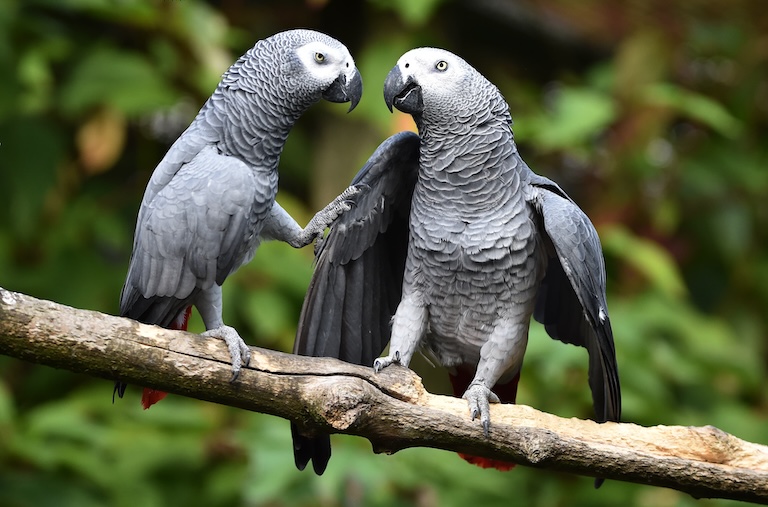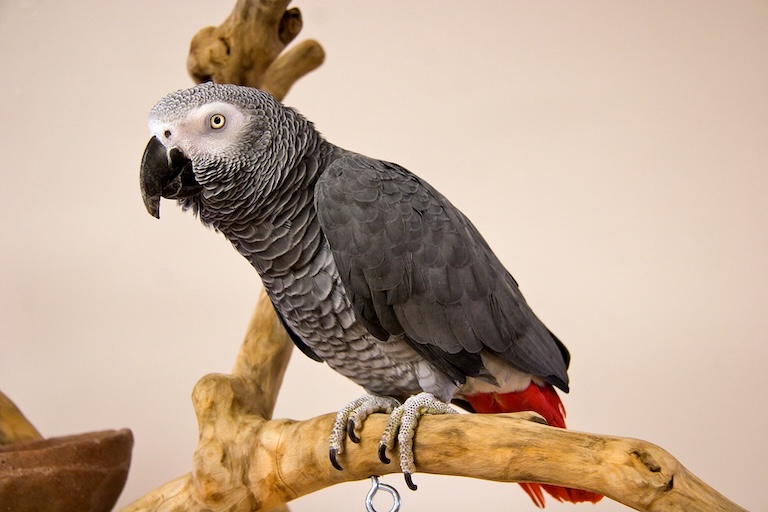Grey Parrot Profile
When someone is said to be parroting something, it’s usually a reference to the mindless regurgitation of information, often something that was heard in the pub or on any of the Oligarchian social media platforms; spewed forth without any consideration for what it actually meant or whether the “parrot” understood it at all.
But in reality, this is a bit of an insult to parrots, who, as we’re starting to discover, often know exactly what they’re talking about. And the most accomplished orator of them (that we can understand so far) is the African grey.

Grey Parrot Facts Overview
| Habitat: | Dense forest, usually lowland, forest edges, urban environments |
| Location: | Equatorial Africa |
| Lifespan: | 60 + years in captivity, average 23 in the wild |
| Size: | Around 52 cm (21 in) long |
| Weight: | Up to 526 g (19 oz) |
| Colour: | Lightest grey around the eyes, light grey belly, dark grey back, red tail tip |
| Diet: | Fruit, nuts, seeds |
| Predators: | Palm-nut vultures, eggs eaten by monkeys |
| Top Speed: | Unknown |
| No. of Species: | 1 |
| Conservation Status: | Endangered (IUCN) |
Grey parrots are some of the smartest animals we recognise. Given the inherent bias we bring to the table, it’s quite possible they outsmart us.
While they’re routinely compared with 6-year-old human children in their cognitive abilities, they no doubt do something similar with us, being bald, flightless and unable to crack nuts in our mouths.
Regardless, they are phenomenally impressive animals and have so much to teach us about the convergent evolution of intelligence.
Interesting Grey Parrot Facts
1. They’re basal parrots
Grey parrots are some of the most primitive, or basal parrot species alive. This doesn’t mean they’re in any way inferior – and as we’ll see, they’re not – instead, it refers to their relationship with the closest common ancestor of all parrots.
This species is more closely related to the ancestral parrots than most are, making it one of the oldest lineages of parrots left in the world.
2. They’re extremely social
Good luck getting close to wild Grey parrots – they’re smart enough not to let anybody approach them. But they are quite content among their own kind, nesting and roosting in large family groups, which take up their own tree among the wider group of multiple families.
Groups like this are loud, and unlike other species, the grey exhibits more of a sense of exclusivity, gathering in groups that are made up only of their kind.
They’ll break up during the day into smaller groups to find food, and their young will stay with the family for many years.
Young birds are educated by their elders until they’re old enough to become independent and grow from subservient to more assertive and pushier for dominance.
These are intelligent birds, whose culture is important to their success. Unlike many animals with innate, instinctive understandings of their world, the complexity of grey parrot life necessitates a supreme intellect. And greys have that in droves. 1

3. They’re crazy smart
The term “Bird-brained” is a stark reminder of the ignorance of the human mind. A mind whose executive functions are mediated by a bulging neural appendage known as the prefrontal cortex.
Birds don’t have one of these, but they do have something remarkably similar called the nidopallium caudolaterale (This is presumably a bird word because it’s very difficult to pronounce it with a human mouth, we’ll call it the NCL).
Essentially this encodes the subjective experience in birds, giving them a sense of who they are, among other things. Almost all research done into this part of the avian brain uses Corvids as the model organism.
Corvids are well known to be intelligent birds, but grey parrots are likely even smarter.
Greys are thought to be one of the most intelligent animals on the planet, though this ranking is very biased toward human cognition. Still, in human-designed tests, they perform excellently. One of the most obvious signifiers of human intelligence is how well they speak. 2 3
4. They can speak English
We’re beginning to realise that plenty of animals talk to one another. Toothed whales, like dolphins, are well known for it, and elephants appear to be quite vocal, too.
It’s often said that birds, especially parrots, can talk, but ironically, we’re usually referring to the basic mimicry of words we use. Many birds have such well-developed vocal apparatus that they can copy the sound of a human voice almost perfectly.
But this isn’t talking as such – any more than it would be if a person barked like a dog.
But when those sounds are coupled with their meanings, we start to enter the world of communication, and African grey parrots are quite well known for this among behaviourists.
These parrots can identify objects by name, tell a researcher what colour it is and how many there are, and even create new labels based on human language verbal rules.
The highest performing of them has been compared with a 6-year-old human child, and considering the immense bias involved, it’s possible that these parrots would compete with or even surpass some of our smartest minds in certain intellectual tasks. 4
5. They use mirrors
This is another thing birds are known for, but more often than not they see their reflection as another member of their species and try to feed or fight it.
Anyone who’s ever owned a budgie will likely remember clearing off all the regurgitated seed paste from its mirror from the generous gifts it would produce to what it thought was a companion.
The grey part is an interesting case, though. While it’s able to process mirrored information, it doesn’t appear to recognise itself or show any interest in its reflection.
When tested with a mark on their feathers, grey parrots didn’t appear to respond to that mark in their reflections. However, they were able to locate hidden objects using the mirrors, and their specific behaviour on all the tasks represents the first non-mammalian example of success in these kinds of tests.
But it’s worth remembering that the specific mirror test for self-awareness is a strange one. Pigeons and magpies can pass it, but crows and grey parrots can’t. Even the cleaner wrasse is said to recognise its reflection!
6. They swear
Considering all benchmarks of intelligence are set to human’s own upper limit, we as a species sure are easily offended by what are essentially sounds taken out of context.
So, when a group of captive parrots from Lincolnshire Wildlife Park in the UK began mouthing off like a bunch of old sailors, someone had to think of the children!
Five grey parrots were introduced and quickly started teaching the rest of the group how to properly curse and instead of laughing it off, the decision was made to correct the behaviour.
However, given some time to ponder the situation, the chief exec came to the sensible conclusion that nobody will be all that traumatised if they hear a bird swear and it might be quite funny, actually.
The birds have since gone back on display.
7. They listen to music
Grey parrots like rock music. That should be enough to convince anyone they’re smart, and if it’s not, they can also be seen dancing and singing along.
But not all birds have the same taste in music. Some prefer upbeat pop and others prefer soothing, ambient music.
But they all seem to like rock, which is important.
And while the wrong Amazon is burning, the one that we’re stuck with is providing smart speakers which these parrots have learned to use, requesting their favourite songs on Amazon Echo and Google Nest devices.

Grey Parrot Fact-File Summary
Scientific Classification
| Kingdom: | Animalia |
| Phylum: | Chordata |
| Class: | Aves |
| Order: | Psittacciformes |
| Family: | Psittacidae |
| Genus: | Psittacus |
| Species: | erithacus |
Fact Sources & References
- Rachel Holman, “Psittacus erithacus grey parrot”, Animal Diversity Web.
- Irene M. Pepperberg (2012), “Further evidence for addition and numerical competence by a Grey parrot (Psittacus erithacus)”, Springer Nature Link.
- Onur Güntürkün (2005), “The avian ‘prefrontal cortex’ and cognition”, NIH.
- Irene M. (1994), “Numerical competence in an African gray parrot (Psittacus erithacus)”, APA PsycNet.
